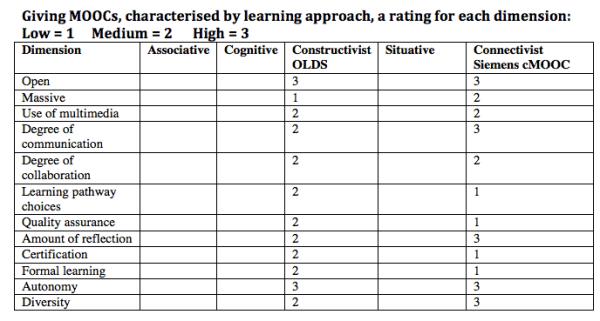As a part of Open Education Week 2014, Professor Gráinne Conole and I plan to hold a webinar (details to be announced shortly; watch this space) on the topic of A Pedagogical Look at MOOCs. This webinar is not simply a University of Leicester production; it will be part of the EU-funded eMundus project, one task of which is to map out patterns of open educational partnerships between institutions around the world. An example of such a partnership would be the OER University, or a university accepting some form of credit for successful completion of a MOOC.
Our webinar will take a pedagogical look at MOOCs in the following way: first we choose 5 MOOCs, each corresponding to a primary learning approach taken in the MOOC. Then we map each MOOC against 12 dimensions identified originally by Grainne in her blog post “A New Classification for MOOCs” (and with thanks to Stephen Downes for identifying the last two dimensions (Downes, 2010)). Below is my initial attempt, having chosen only 2 MOOCs so far: the Open University Learning Design MOOC (OLDS), which I identify as constructivitst, and the original George Siemens Connectivist MOOC. Many thanks to Paul Rudman for his input on this mapping exercise as well.
One obvious question is: how does one pedagogically categorise a MOOC? Another big question: how are we defining these dimensions and what would constitute Low, Medium, or High for each one. I am interested in your views on these and other questions — please comment! I include the webinar abstract at the end of this post.

Webinar Abstract: As the number and variety of free online courses and MOOCs increases, it becomes more important to be aware of their differing pedagogical approaches. After initial attempts to categorise MOOCs as cMOOCs and xMOOCs (roughly, C for connectivist and X for EdX –style), it began to be clear that more nuanced categorisation was needed, and especially when considering the course’s primary learning approaches. Taking Conole’s 12-dimensional MOOC classification (Conole, 2013) and choosing 5 learning approaches often used in elearning (Mayes & De Freitas, 2004) (Bird & Conole, 2013), we categorise 5 MOOCs as an exploratory exercise for this webinar. Does this exercise display clues to the direction of MOOCs and free online courses in general? Are there any warning signals which we as educators should note? In the context of the eMundus project, does this classification help quality officers make decisions in open educational practice, for example about accepting credit for a completed MOOC?
Bird, T., & Conole, G. (2013). From E-Learning to M-Learning. In From E-Learning to M-Learning. Singapore. Retrieved from http://www.slideshare.net/tbirdcymru/from-elearning-to-mlearning
Conole, G. (2013). A new classification for MOOCs. e4innovation Blog. Retrieved January 25, 2014, from http://www.e4innovation.com/?p=727
Downes, S. (2010). Fairness and equity in education. Huff Post Education.
Mayes, T., & DeFreitas, S. (2004). JISC e-Learning Models Desk Study Stage 2 : Review of e-learning theories , frameworks and models.
Terese Bird, Learning Technologist and SCORE Research Fellow, Institute of Learning Innovation, University of Leicester




